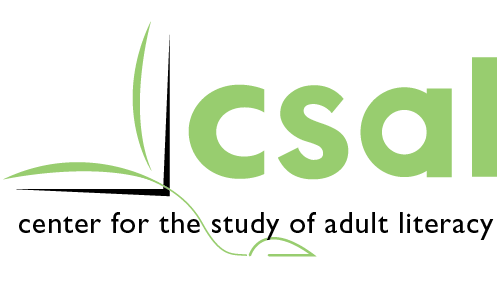Phase 1 Assessment Battery
A. Basic Reading Components:
Phonological:
Comprehensive Test of Phonological Processing (CTOPP2): (Wagner, Torgesen, Rashotte & Pearson)
a. Blending Words: Participants are asked to blend together sounds they hear to make a real word.
b. Elision: Participants are asked to repeat words without specific sounds to make a different real word.
c. Phonemic Isolation: Participants are asked to isolate sounds within words.
Morphological:
Comprehensive Assessment of Spoken Language (CASL): (Carrow-Woolfolk)
Grammatical Morphemes: Participants complete word analogies that have a morphological relationship.
Decoding:
Woodcock-Johnson-III NU: (Woodcock, McGrew, & Mather)
Word Attack: Participants read aloud a list of decodable nonwords of increasing difficulty.
Orthographic/Irregular Word Reading:
Test of Irregular Word Reading Efficiency (TIWRE): (Reynolds & Kamphaus)
Participants are presented with irregularly spelled words and asked to read as many as possible.
Word Reading Accuracy:
Woodcock-Johnson-III NU: (Woodcock, McGrew, & Mather)
Letter-Word Identification: Participants read aloud a list of increasingly difficult words.
Vocabulary:
1. Woodcock-Johnson-III NU: (Woodcock, McGrew, & Mather)
Picture Vocabulary: Participants are shown pictures of objects and asked to provide names.
2. Clinical Evaluation of Language Fundamentals – 4th Edition (CELF-4): (Semel, Wiig, & Secord)
a. Word Classes 2: Participants are given a set of words and asked which two go together and how they go together.
b. Word Definitions: Participants are asked to define a word as it is used in a sentence given by an examiner.
Fluency – Word Reading Fluency:
1. Test of Word Reading Efficiency (TOWRE-2): (Torgesen, Wagner, & Rashotte)
a. Sight Word Reading Efficiency: Participants are given 45 seconds to read aloud as many words as they can.
b. Phonemic Decoding Efficiency: Participants are given 45 seconds to read aloud as many nonwords as they can.
2. Test of Silent Word Reading Fluency (TOSWRF): Mather, Hammill, Allen, & Roberts)
(Please note that this link connects you to the latest edition of the test, a version that did not exist during the beginning of our data collection)
Participants are presented with rows of words that do not have spaces between them, and asked to mark the boundaries of as many words as they recognize in 3 minutes.
Fluency – Connected Text Fluency:
1. Woodcock-Johnson-III NU: (Woodcock, McGrew, & Mather)
Reading Fluency: Participants are given 3 minutes to read a list of statements and decide if they are true or false.
2. Test of Silent Contextual Reading Fluency (TOSCRF): (Hammill, Wiederholt, & Allen)
(Please note that this link connects you to the latest edition of the test, a version that did not exist during the beginning of our data collection)
Participants are given short passages that are written without spaces between the words, and they are asked to mark the boundaries of all the words they recognize within 3 minutes.
B. Deeper Comprehension Components:
General Knowledge/Background Information:
1. Woodcock-Johnson-III NU: (Woodcock, McGrew, & Mather)
a. General Information Subtests: Participants answer questions about common objects.
b. Academic Knowledge Subtests: Participants answer oral questions about factual knowledge of science, social studies, and humanities.
Reasoning:
1. Comprehensive Assessment of Spoken Language (CASL): (Carrow-Woolfolk)
a. Nonliteral Language: Examiner gives a scenario involving nonliteral language and the participant is asked to explain the meaning.
b. Meaning from Context: Participant is asked to define an uncommon word by using context cues.
c. Inference: Participant answers questions based on oral scenarios presented by examiner. Part of the information is missing, so the participant needs to use background/world knowledge to infer the missing information
d. Ambiguous Sentences: Participant is asked to give two meanings of stimuli orally presented by the examiner.
Oral Comprehension:
1. Woodcock-Johnson-III NU: (Woodcock, McGrew, & Mather)
a. Story Recall: Participants listen to a passage and then recall as many details about it as they can remember.
b. Understanding Directions: Participants listen and follow increasingly complex oral instructions to point to different parts of pictures.
2. Clinical Evaluation of Language Fundamentals – 4th Edition (CELF-4): (Semel, Wiig, & Secord)
Understanding Spoken paragraphs: Participants answer questions about passages orally presented by the examiner.
Written Comprehension:
1. Woodcock-Johnson-III NU: (Woodcock, McGrew, & Mather)
Passage Comprehension: Participants silently read passages and fill in the missing word.
Memory: Long-Term Memory Retrieval:
1. Woodcock-Johnson-III NU: (Woodcock, McGrew, & Mather)
Retrieval Fluency: Participants name as many examples as possible for a given category within a 1-minute time period.
Memory: Short-Term Memory Retrieval:
1. Woodcock-Johnson-III NU: (Woodcock, McGrew, & Mather)
a. Numbers Reversed: Participants repeat increasingly long series of dictated digits in reversed order.
b. Memory for Words: Participants repeat a list of unrelated words in the correct sequence.
2. Clinical Evaluation of Language Fundamentals – 4th Edition (CELF-4): (Semel, Wiig, & Secord)
Recalling Sentences: Participants repeat sentences of increasing length and grammatical complexity.
Working Memory/Division of Memory/Attention Control:
1. Woodcock-Johnson-III NU: (Woodcock, McGrew, & Mather)
Auditory Working Memory: Participants repeat a list of randomly dictated words and numbers with the words first and then the numbers in the order they were dictated.
C. Motivation
1. Reading Motivation Scale: (RMS: Guthrie & Wigfield, 2009)
Participants are asked questions pertaining to their motivation for, breadth of, and depth of reading.
2. Intrinsic Motivation Inventory: (IMI: Ryan, 2002)
Participants are asked questions pertaining to their intrinsic motivation toward reading.
3. Expectancy Value Questionnaire (EVQ): (Eccles & Wigfield, 1995; 2002)
Assesses participant’s cognitive appraisal of expectancy for success and affective evaluation of the participant’s learning target (i.e., reading).
4. Affective Episode Interview: (Gorges & Kandler, 2012)
Participants are asked two questions pertaining to previous experiences in reading.
D. “In-House” Developed Questionnaires:
1. Demographic Survey
Participants are asked questions pertaining to demographics such as race, gender, country of birth, English language status, education, and employment. A US Demographic Survey and a Canadian Demographic Survey were created.
2. Computer Familiarity
Participants are asked questions about their computer knowledge and use.
3. Reading Practices
Participants are asked questions pertaining to their frequency of reading different types of print.
